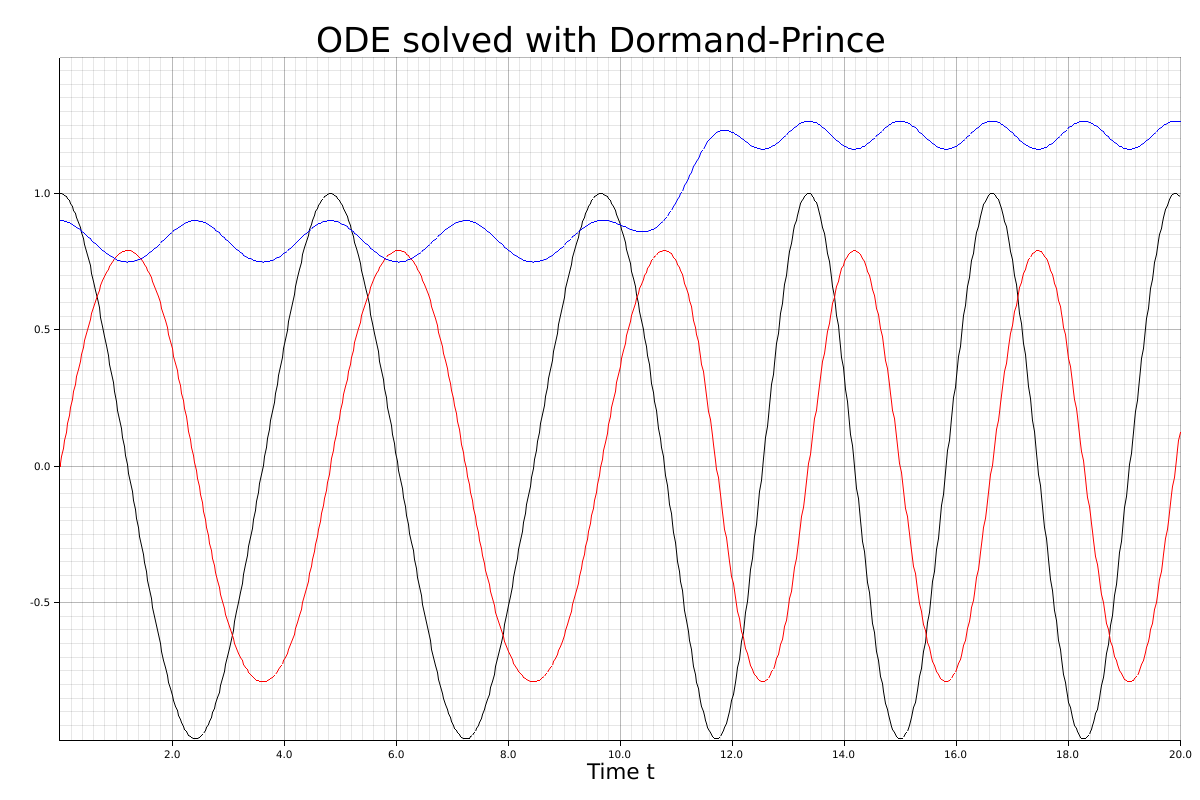Explicit Methods
Therewith an ordinary differential equation can be solved, it is necessary, that it is writable in
explicit form:
Given $f$, a function of $x$, $y$, and derivatives of $y$. Then an equation of the form
$$ f ( x , y , y′ , \dots, y^{ (n − 1) } ) = y^{(n)} $$
is called an explicit ordinary differential equation of order $n$.
$$
\begin{pmatrix}
y_{1} \\
y_{2} \\
y_{3} \\
\end{pmatrix}^{’}
=
\begin{pmatrix}
(I_{2} - I_{3})/I_{1} y_{2} y_{3} \\
(I_{3} - I_{1})/I_{2} y_{3} y_{1} \\
(I_{1} - I_{2})/I_{3} y_{1} y_{2} + f(x) \\
\end{pmatrix}
$$
$$
f(x) =
\begin{cases}
0.25 sin^2(x) & if 3\pi \leq x \leq 4 \pi \\
0 & otherwise \\
\end{cases}
$$
We choose the constants and initial condition as:
$$
I_{1} = 0.5, I_{2} = 2, I_{3} = 3, i_{1}(0) = 1.0, i_{2}(0) = 0.0, i_{3}(0) = 0.9
$$
and solve the initial value problem in the interval $t \in [0, 20.0]$
pub struct Euler<T>
{
i1: T,
i2: T,
i3: T,
time_span: (T, T),
init_cond: Vector<T>
}
impl<T> Default for Euler<T>
where T: Real
{
fn default() -> Euler<T> {
Euler
{
i1: T::from_f64(0.5),
i2: T::from_f64(2.0),
i3: T::from_f64(3.0),
time_span: (T::from_f64(0.0), T::from_f64(20.0)),
init_cond: vector![T::from_f64(1.0); T::from_f64(0.0); T::from_f64(0.9)]
}
}
}
impl<T> ExplicitODE<T> for Euler<T>
where T: Real
{
fn func(self: &Self, x: &T, y: &Vector<T>) -> Vector<T> {
let y_1s: T = ((self.i2 - self.i3) / self.i1) * (*y.get(1) * *y.get(2));
let y_2s: T = ((self.i3 - self.i1) / self.i2) * (*y.get(2) * *y.get(0));
let f: T;
if *x >= T::from_f64(3.0) * T::pi() && *x <= T::from_f64(4.0) * T::pi()
{
f = T::from_f64(0.25) * x.sin() * x.sin();
}
else
{
f = T::zero();
}
let y_3s: T = ((self.i1 - self.i2) / self.i3) * (*y.get(0) * *y.get(1)) + f;
return vector![y_1s; y_2s; y_3s];
}
fn time_span(self: &Self) -> (T, T) {
return self.time_span;
}
fn init_cond(self: &Self) -> Vector<T> {
return self.init_cond.clone();
}
}
Now we solve this ODE with the Dormand-Prince method:
1
2
3
4
5
6
7
8
9
10
11
12
13
14
15
16
17
18
19
20
21
22
23
24
25
26
27
28
29
30
31
32
33
34
35
36
37
38
39
40
41
42
43
44
45
46
47
48
49
50
51
52
53
54
55
56
57
58
59
60
61
62
63
64
65
66
67
68
69
70
71
72
73
74
75
76
77
|
use mathru::{
algebra::linear::vector::Vector,
analysis::differential_equation::ordinary::{
problem::Euler,
solver::explicit::runge_kutta::adaptive::{DormandPrince54, ProportionalControl},
ExplicitInitialValueProblemBuilder,
},
vector,
};
use plotters::prelude::*;
fn main() {
let x_start: f64 = 0.0;
let x_end: f64 = 20.0;
// Create an ODE instance
let explicit_euler = Euler::default();
let problem = ExplicitInitialValueProblemBuilder::<f64, Euler<f64>>::new(
&explicit_euler,
x_start,
vector![1.0; 0.0; 0.9],
)
.t_end(x_end)
.build();
// Create a ODE solver instance
let h_0: f64 = 0.0001;
let fac: f64 = 0.9;
let fac_min: f64 = 0.01;
let fac_max: f64 = 2.0;
let n_max: u32 = 800;
let abs_tol: f64 = 10e-7;
let rel_tol: f64 = 10e-6;
let solver: ProportionalControl<f64> =
ProportionalControl::new(n_max, h_0, fac, fac_min, fac_max, abs_tol, rel_tol);
// Solve ODE
let (x, y): (Vec<f64>, Vec<Vector<f64>>) =
solver.solve(&problem, &DormandPrince54::default()).unwrap();
//Create chart
let mut graph_x1: Vec<(f64, f64)> = Vec::with_capacity(x.len());
let mut graph_x2: Vec<(f64, f64)> = Vec::with_capacity(x.len());
let mut graph_x3: Vec<(f64, f64)> = Vec::with_capacity(x.len());
for i in 0..x.len() {
let x_i = x[i];
graph_x1.push((x_i, y[i][0]));
graph_x2.push((x_i, y[i][1]));
graph_x3.push((x_i, y[i][2]));
}
let root_area =
BitMapBackend::new("./figures/ode_dormandprince.png", (1200, 800)).into_drawing_area();
root_area.fill(&WHITE).unwrap();
let mut ctx = ChartBuilder::on(&root_area)
.margin(20)
.set_label_area_size(LabelAreaPosition::Left, 40)
.set_label_area_size(LabelAreaPosition::Bottom, 40)
.caption("ODE solved with Dormand-Prince", ("Arial", 40))
.build_cartesian_2d(x_start..x_end, -1.0f64..1.5f64)
.unwrap();
ctx.configure_mesh()
.x_desc("Time t")
.axis_desc_style(("sans-serif", 25).into_font())
.draw()
.unwrap();
ctx.draw_series(LineSeries::new(graph_x1, &BLACK)).unwrap();
ctx.draw_series(LineSeries::new(graph_x2, &RED)).unwrap();
ctx.draw_series(LineSeries::new(graph_x3, &BLUE)).unwrap();
}
|
The following picture illustrates the solution for this ODE:

